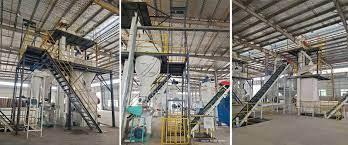Unveiling the Enigma: A Journey Through the Intricate World of Cat Litter Factories

Introduction:
In the realm of pet care, cat litter stands as a silent hero, catering to the needs of millions of feline companions and their owners worldwide. While we scoop, pour, and sift through this essential product daily, the intricate process that transforms raw materials into the magical substance that keeps our homes clean often goes unnoticed. Join us on a fascinating journey as we unveil the secrets of a cat litter factory, exploring the meticulous steps involved in crafting this indispensable product.
Raw Materials Harvesting:
The journey begins with the extraction of raw materials essential for cat litter production. Traditionally, clay has been the primary ingredient due to its exceptional absorbent qualities. However, the rise of environmental awareness has spurred innovation, leading to the use of alternative materials such as recycled paper, wood, corn, and silica gel. Sustainable sourcing practices are increasingly becoming a priority for manufacturers, ensuring a balance between quality and eco-friendliness.
Processing and Purification:
Once the raw materials are harvested, they undergo a series of processing and purification steps. In the case of clay, it is mined and purified to remove impurities. Other materials might be subjected to drying, shredding, or chemical treatments to attain the desired texture and absorbency. This stage is crucial in laying the foundation for a high-quality cat litter product.
Formulation and Mixing:
The alchemy of cat litter creation lies in the formulation and mixing of the raw materials. Manufacturers carefully blend different components in precise proportions to achieve the optimal balance of absorbency, clumping ability, and odor control. Research and development teams invest significant efforts in fine-tuning these formulas, aiming to create a product that not only meets but exceeds the expectations of cat owners and their discerning feline companions.
Shaping and Drying:
The mixed material is then shaped into the familiar granules or pellets that define cat litter. This can be achieved through extrusion or molding processes. To prevent premature clumping, the newly formed litter undergoes a thorough drying process to eliminate excess moisture. The result is a product that is not only effective but also easy to handle and store.
Incorporating Special Features:
To cater to the diverse needs of cat owners, manufacturers often introduce special features into their products. Natural additives like baking soda may be included for enhanced odor control, while antimicrobial agents can inhibit bacterial growth. These additional features elevate the overall performance of the cat litter, providing a customized solution for various preferences and requirements.
Packaging Innovation:
The cat litter journey continues with careful consideration of packaging. Factors such as weight, size, and sustainability play a crucial role in this stage. Some manufacturers prioritize eco-friendly packaging, responding to the growing demand for sustainable pet care solutions. The packaging not only serves as a protective shell but also communicates the values of the brand to environmentally conscious consumers.
Stringent Quality Control:
Ensuring the consistency and quality of cat litter is paramount. Each batch undergoes rigorous testing to meet predefined standards for absorbency, clumping, and odor control. This commitment to quality control guarantees that cat owners receive a reliable product every time they purchase a bag of cat litter. This step is a testament to the dedication of manufacturers to provide a product that exceeds expectations.
Environmental Responsibility:
In an era marked by heightened environmental awareness, cat litter manufacturers are increasingly adopting sustainable practices. Some focus on using biodegradable materials, while others implement recycling programs for their packaging. The aim is to align pet care with broader environmental concerns, offering consumers a guilt-free option that considers the planet's well-being.
Distribution and Supply Chain:
From the cat litter factory, the product embarks on a journey through a complex distribution and supply chain. Trucks, trains, and ships become the vessels that transport cat litter to distribution centers, eventually finding their way to pet stores and supermarkets worldwide. The efficiency of this supply chain ensures that cat litter is readily available to meet the demands of cat owners everywhere.
Conclusion:
The cat litter factory is a fascinating intersection of science, innovation, and environmental consciousness. As we scoop our cat's litter box, it's worth pausing to appreciate the intricate journey that transforms humble raw materials into the essential product that keeps our homes clean and our feline friends content. The cat litter factory is indeed a hidden world, and by unraveling its secrets, we gain a newfound appreciation for the diligence and innovation driving the creation of this seemingly simple yet indispensable pet care product.
- Art
- Causes
- Crafts
- Dance
- Drinks
- Film
- Fitness
- Food
- Giochi
- Gardening
- Health
- Home
- Literature
- Music
- Networking
- Altre informazioni
- Party
- Religion
- Shopping
- Sports
- Theater
- Wellness
- IT, Cloud, Software and Technology


